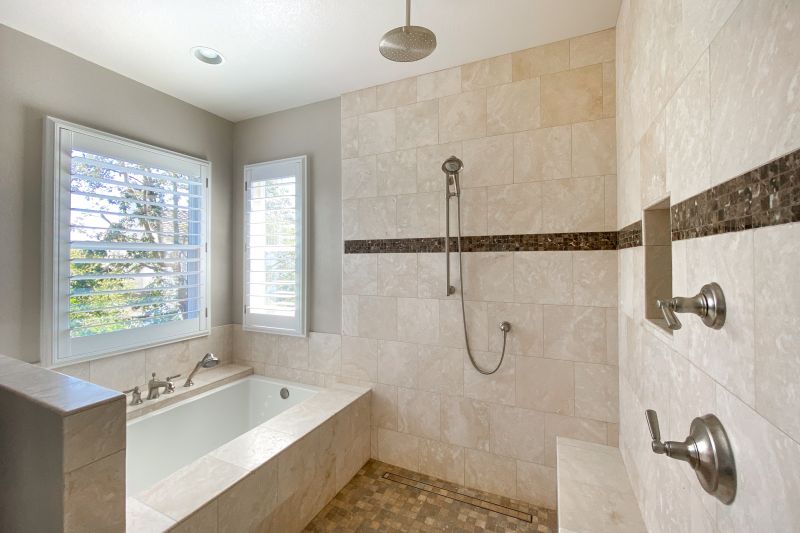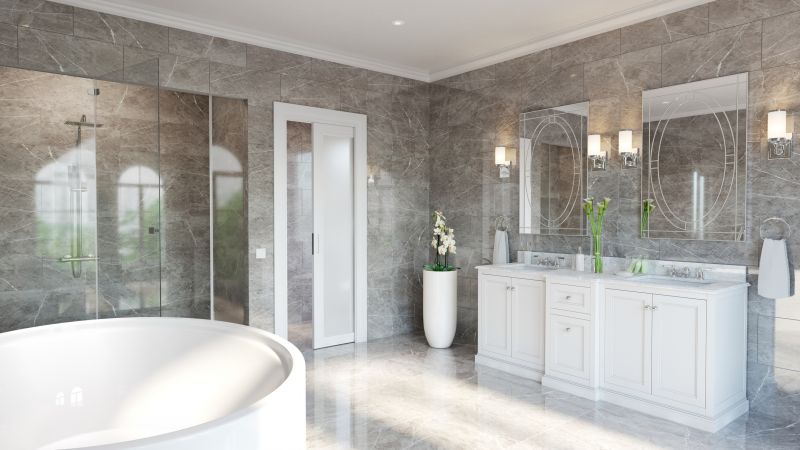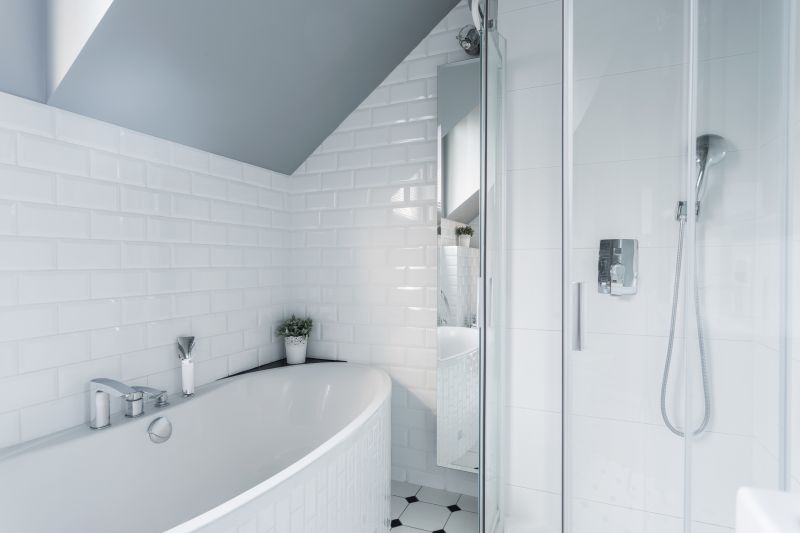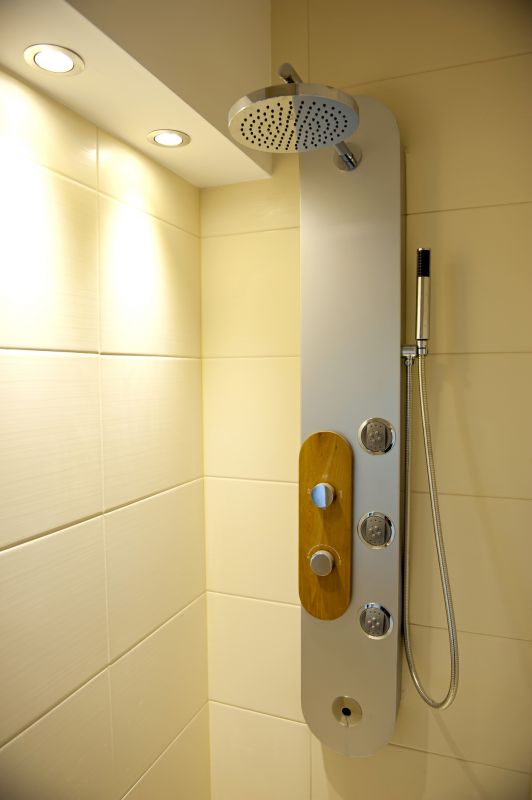Shower Resurfacing Tips
Shop for Shower Resurfacing Tips

Shower resurfacing is an effective way for homeowners to refresh the look of their bathrooms without the need for a full remodel. This process involves applying a new surface layer to your existing shower enclosure, which can rejuvenate its appearance and extend its lifespan. When considering shower resurfacing, it is important to evaluate various attributes such as materials, finishes, and compatibility with your current setup.
One of the primary considerations in shower resurfacing is the choice of material. Common options include acrylic, epoxy, and urethane finishes. Each material offers distinct benefits in terms of durability, ease of maintenance, and aesthetic appeal. For instance, acrylic is known for its glossy finish and resistance to mold and mildew, making it a popular choice for humid environments like bathrooms.
The finish is another critical aspect to consider. Homeowners can choose from a range of finishes, including matte, semi-gloss, and high-gloss. The choice of finish will impact not only the look of the shower but also its maintenance requirements. High-gloss finishes tend to show water spots more readily, while matte finishes can provide a more subdued, contemporary appearance.
Dimensions and compatibility with existing bathroom fixtures are also key factors. Resurfacing materials must be able to adhere properly to the existing surfaces, and the dimensions of the shower area should be accurately measured to ensure a seamless application. In some cases, minor modifications may be necessary to accommodate the new surface layer.
When selecting resurfacing options, homeowners in Aberdeen, North Carolina, should consider the local climate and water quality. The humid conditions can affect the longevity of certain materials, so choosing a finish that offers resistance to moisture and mildew is advisable. Additionally, water hardness can impact the appearance and maintenance of the resurfaced shower over time.
Upkeep expectations are an essential part of the decision-making process. Regular cleaning with non-abrasive products will help maintain the appearance and integrity of the new surface. It is important to follow manufacturer recommendations for cleaning and maintenance to ensure the longevity of the resurfaced shower.
- Material: Acrylic, Epoxy, Urethane
- Finish: Matte, Semi-gloss, High-gloss
- Dimensions: Customizable to existing space
- Maintenance: Regular cleaning with non-abrasive products
- Compatibility: Ensure adhesion to existing surfaces
Acrylic Finish
Offers a glossy appearance with excellent mold resistance, ideal for humid environments.
Epoxy Coating
Provides a durable and water-resistant layer, suitable for high-traffic shower areas.
Urethane Finish
Known for its flexibility and resistance to cracking, perfect for older showers.
| Attribute | Description |
|---|---|
| Material | Acrylic, Epoxy, Urethane |
| Finish | Matte, Semi-gloss, High-gloss |
| Dimensions | Customizable |
Understanding Materials and Finishes for Shower Resurfacing
Shop for Understanding and Finishes for Shower Resurfacing
A Comprehensive Guide to Choosing the Right Materials and Finishes
When considering shower resurfacing, selecting the appropriate materials and finishes is crucial for achieving both aesthetic appeal and durability. Homeowners in Aberdeen, North Carolina, and beyond should focus on materials that withstand humidity and frequent use, while enhancing the overall look of the bathroom. The choice of materials and finishes can greatly influence the longevity and maintenance requirements of your shower space.
Ceramic and porcelain tiles are popular choices due to their water resistance and variety of styles. These materials offer a range of finishes, from matte to glossy, allowing homeowners to tailor the look to their personal taste. Porcelain tiles, in particular, are known for their durability and low maintenance, making them a practical option for busy households.

Natural stone, such as marble or granite, provides a luxurious finish that can elevate the bathroom's aesthetic. However, these materials require regular sealing to maintain their appearance and prevent moisture damage. Homeowners should consider the upkeep involved with natural stone before making a decision, as it can be more demanding than other materials.
For those seeking a modern look, glass tiles offer a sleek and contemporary finish. They reflect light beautifully, creating an illusion of space, which is especially beneficial for smaller bathrooms. However, glass tiles can be slippery when wet, so it's important to consider slip resistance when selecting this material for shower floors.
Another consideration is the use of acrylic panels, which provide a seamless look and are easy to clean. Acrylic is resistant to mold and mildew, making it a hygienic choice for shower resurfacing. It is also lightweight and can be installed over existing surfaces, reducing the need for extensive demolition work.
In addition to material selection, the finish of the shower fixtures should complement the overall design. Options like brushed nickel, chrome, and oil-rubbed bronze offer different aesthetic appeals and maintenance levels. Chrome, for example, is easy to clean and highly resistant to corrosion, while oil-rubbed bronze provides a rustic look but may require more frequent cleaning to prevent water spots.
| Material | Finish | Dimensions |
|---|---|---|
| Ceramic Tile | Matte, Glossy | Varies |
| Porcelain Tile | Matte, Glossy | Varies |
| Natural Stone | Polished, Honed | Varies |
| Glass Tile | Glossy | Varies |
| Acrylic Panel | Glossy, Matte | Custom |
- Water resistance
- Durability
- Maintenance requirements
- Style compatibility
- Slip resistance
Sizing and Compatibility Considerations for Shower Resurfacing
Shop for Sizing and Compatibility Considerations for Shower Resurfacing
Ensuring Proper Fit and Functionality in Your Bathroom
When considering shower resurfacing for a bathroom renovation, homeowners in Aberdeen, North Carolina, should pay close attention to sizing and compatibility. The first step is understanding the dimensions of the existing shower space and how any changes might affect the overall layout. It's crucial to measure the height, width, and depth of the shower area to ensure that any new materials or finishes will fit seamlessly into the existing space.
The choice of materials is another important factor. Common materials for shower resurfacing include acrylic, fiberglass, and tile. Each material offers different benefits and requires specific maintenance. Acrylic is known for its durability and ease of cleaning, while fiberglass is lightweight and cost-effective. Tile, although more labor-intensive to maintain, offers a wide range of design possibilities. Homeowners should consider their lifestyle and maintenance preferences when selecting a material.
Finish options also play a significant role in the overall aesthetic and functionality of the shower. Matte finishes can help conceal water spots and fingerprints, making them a practical choice for busy households. Glossy finishes, on the other hand, can create a sleek, modern look but may require more frequent cleaning to maintain their shine. Evaluating the pros and cons of each finish will help homeowners select the option that best suits their needs.

Compatibility with existing plumbing and fixtures is another consideration. It's important to ensure that new surfaces align with current plumbing setups to avoid costly adjustments. This includes checking the location of showerheads, faucets, and drains. Homeowners should verify that any new resurfacing materials or features do not interfere with these existing elements.
Maintaining the resurfaced shower is essential for prolonging its lifespan. Different materials and finishes require varied upkeep routines. For instance, tile may need regular grout sealing, while acrylic surfaces might only need occasional polishing. Understanding these maintenance requirements will ensure that the shower remains in good condition for years to come.
Finally, homeowners should consider additional features and options that can enhance the shower experience. These might include built-in shelving, seating, or grab bars for added safety and convenience. Incorporating these elements into the design can improve both the functionality and accessibility of the shower space.
- Material: Acrylic, Fiberglass, Tile
- Finish: Matte, Glossy
- Dimensions: Customizable to fit existing space
- Features: Built-in shelving, seating, grab bars
Acrylic
Durable and easy to clean, suitable for high-traffic bathrooms.
Fiberglass
Lightweight and cost-effective, ideal for quick installations.
Tile
Offers a range of designs, requires regular maintenance.
| Attribute | Details |
|---|---|
| Material | Acrylic, Fiberglass, Tile |
| Finish | Matte, Glossy |
| Dimensions | Customizable |
| Features | Built-in shelving, seating, grab bars |





